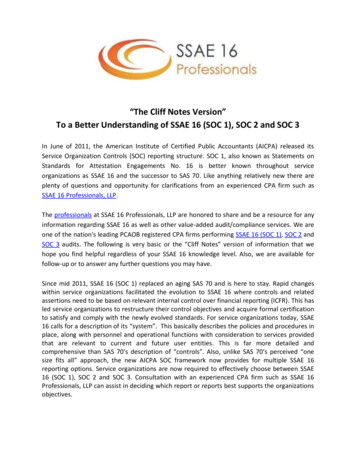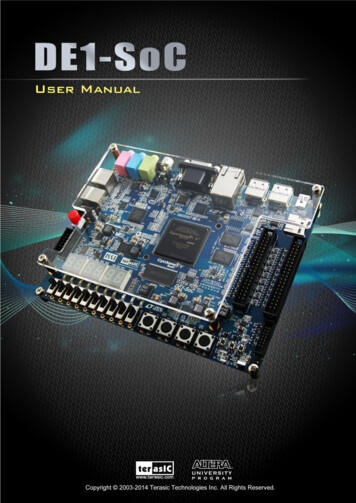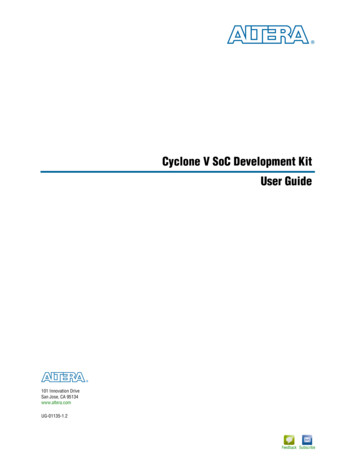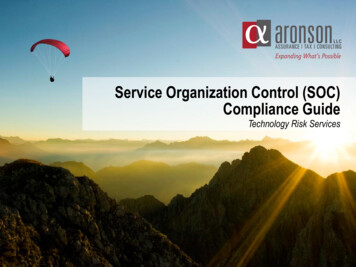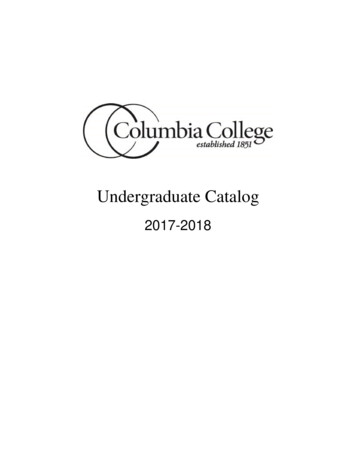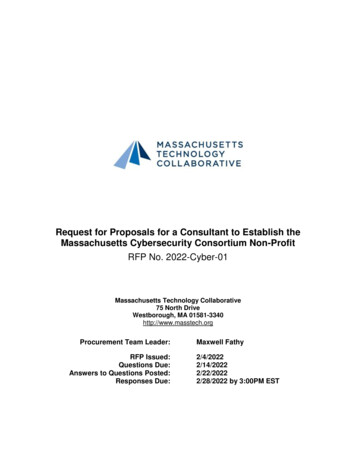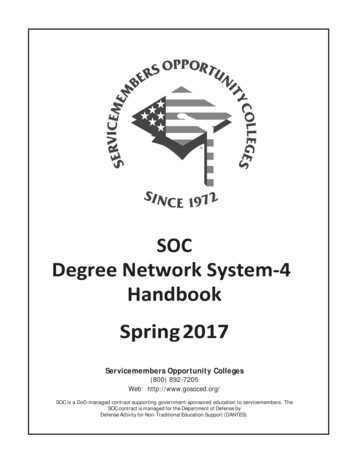
Transcription
SOCDegree Network System-4HandbookSpring 2017Servicemembers Opportunity Colleges(800) 892-7205Web: http://www.gosoced.org/SOC is a DoD-managed contract supporting government-sponsored education to servicemembers. TheSOC contract is managed for the Department of Defense byDefense Activity for Non-Traditional Education Support (DANTES).
TABLE OF CONTENTSChapter 1The Servicemembers Opportunity Colleges (SOC) Degree Network System . 1-1Chapter 2Student Agreement . 2-1Chapter 3Colleges and Degree Programs . 3-1Chapter 4Member School Locations . 4-1Chapter 5Transferability Policies and Tables . 5-1Chapter 6The Servicemembers Opportunity Colleges (SOC) Student Overview . 6-1Appendix.Appendix-1Page iiSOC Degree Network System-4 Handbook Spring 2017
CHAPTER 1Chapter 1The Servicemembers Opportunity Colleges(SOC) Degree Network SystemSOC Degree Network System Overview . 1-2Membership . 1-2Benefits to Institutions from SOC DNS Membership . 1-2Responsibilities of Membership and the Role of theSOC Degree Network System Points-of-Contact (POC) . 1-2The Main SOC DNS POC is Responsible For: . 1-2Specific Annual Tasks for the SOC DNS POC . 1-3Key Components of the SOC Degree Network System . 1-3Networks . 1-3Guaranteed Transferability and SOC DNS Course Categories . 1-3Home College . 1-3Academic Residency. 1-4Degree Program Delivery Methods . 1-4SOC DNS Student Agreements. 1-4Family Member Participation . 1-5Completing Degrees After Military Service . 1-5SOC Degree Network System Credit Evaluation Supplement . 1-5Using the SOC DNS Handbooks . 1-5Chapter 1: Overview of the SOC Degree Network System . 1-5Chapter 2: Student Agreement . 1-5Chapter 3: Colleges and Degree Programs . 1-5Chapter 4: Member School Locations. 1-5Chapter 5: Transferability Policies. 1-6Chapter 6: Student Information. 1-6Appendix. 1-6SOC Degree Network System-4 Handbook Spring 2017Page 1-1
Chapter 1: The Servicemembers Opportunity Colleges (SOC) Degree Network SystemCHAPTER 1SOC Degree Network SystemOverviewThe SOC Degree Network System (DNS) consists ofinstitutions selected to deliver specific associate andbachelor’s degree programs to Service members. TheSOC DNS includes: Degree Network System-2 for associate degrees; and Degree Network System-4 for bachelor’sdegrees.Responsibilities of Membershipand the Role of the SOC DegreeNetwork System Points-of-Contact(POC)The Main SOC DNS POC isResponsible For:The SOC DNS-2 and the SOC DNS-4 function as separatesystems (e.g., an institution may participate in the SOCDNS-4 exclusively, or it may participate in both systems). understanding the Student Agreement process andcoordinating the creation and submission of StudentAgreements for military students who have selectedthe institution as their DNS home college;Membership providing advisement/academic counseling to thestudent or referring them to an advisor;SOC DNS institutions are required to meet a numberof institutional and degree membership criteria forparticipation in the system. Generally when seeking newmember institutions or new or additional degree programs,the DNS will publish a Call for Programs to all institutionsthat are signatories of the DOD MOU. The Calls forPrograms will focus on specific degree programs that arebeing solicited at that time.Institutional members of the SOC DNS agree to specialrequirements and obligations that provide militarystudents with opportunities to complete college degreeswithout suffering loss of academic credit because ofchanges of duty station or other demands of militarycareer. Additional membership expectations are outlinedunder the Role of the SOC DNS Point-of-Contact sectionof this chapter.Benefits to Institutions fromSOC DNS MembershipSOC DNS membership institutions have demonstratedtheir commitment to Service members pursuingeducational goals while balancing the challenges of activemilitary service. Accordingly, SOC DNS membershipserves to assure Service members of this commitment, aswell as to provide higher visibility within the militaryvoluntary education community. DNS member schoolsalso provide details of their academic policies and degreeprograms in the DNS informational media.Page 1-2 keeping SOC staff informed of institutional changes asthey occur; SOC DNS Student Agreement policy andprocedures; understanding the features of the Joint ServicesTranscript (JST); withdrawal and drop procedures, especially howthey relate to students who must suspend their courseattendance due to military obligations; this includesthe provisions of the U. S. Department of EducationReadmission Policy and the HEROES Act of 2003; guaranteed two-way transfer of courses in SOC DNSCourse Category Codes; working directly with SOC DNS personnel tomaintain the requisite level of course transferabilityfor degree programs in Guaranteed-TransferNetworks; and ensuring that all components of the institution arefamiliar with the needs of military students—theseinclude bursar, registrar and advisement services.The SOC DNS conducts an annual cycle of programreview and informational updates. Each memberinstitution is required to identify one main Point-ofContact (POC) to receive all SOC DNS communications.Having a single contact for all SOC DNS matters is criticalto maintaining effective communication between the SOCDNS and institutions. Institutions are asked to notify SOCimmediately of any changes to POC information so thatSOC may update its records accordingly.SOC Degree Network System-4 Handbook Spring 2017
Specific Annual Tasks forthe SOC DNS POC acting as liaison with the DNS during the annualmembership Performance Review. The PerformanceReview serves as an evaluation process for theschool’s participation in the DNS; providing an annual report of military graduates in therequested format by the required deadline; responding to the annual SOC Degree NetworkSystem Handbook update request by the deadlinestated in the request; coordinating the response to SOC DNS CourseCategory circulations within the allotted time frame.Key Components of the SOCDegree Network SystemNetworksA SOC DNS Academic Network consists of a numberof degree programs in a single academic area offeredby SOC DNS member institutions. DNS degrees aregenerally offered through a variety of delivery methods,including distance learning, traditional classroom setting,and prior learning assessment. Some member institutionsoffer traditional and/or blended learning opportunities ata variety of military installations. Member degrees mustachieve a 40 percent standard of two-way GuaranteedTransferability in major and major related courses. Courseswith two-way Guaranteed Transferability are listed in theSOC DNS Transferability Tables.Guaranteed Transferability andSOC DNS Course CategoriesThe Guaranteed-Transfer Networks are designedto maximize guaranteed transferability for as manymajor and major-related course requirements listed indegree programs as possible. Students complete degreerequirements as they change locations during their militarycareers without loss or duplication of credit, or respond toother demands of a military career.A SOC Degree Network System Course Category Codeis established whenever a group of institutions agreesto accept courses in transfer from each other that arecomparable in content. All comparable courses thathave been reviewed and accepted in transfer by Coremember institutions in a particular Course Category aredisplayed in the Transferability Tables under that Code.Core member institutions sharing the same SOC DNSCourse Category must accept each other’s courses in thosecategories in transfer without prior approval. See Chapter5 for a more complete discussion of SOC DNS CourseCategories and transferability policies.Home CollegeThe SOC DNS member institution from which the Servicemember is seeking a degree is designated the “homecollege.” The home college is responsiblefor issuing a SOC DNS Student Agreement (StudentAgreement) when the student has completed his or her firsttwo courses at that school.Guaranteed-Transfer Networks for bachelor’s degrees are:AccountingBusiness AdministrationComputer StudiesCriminal JusticeEducation/Instructional DevelopmentGeneral BusinessHealth Services ManagementHomeland SecurityHuman Resource ManagementInformation Systems echnical ManagementSOC Degree Network System-4 Handbook Spring 2017Page 1-3CHAPTER 1Chapter 1: The Servicemembers Opportunity Colleges (SOC) Degree Network System
Chapter 1: The Servicemembers Opportunity Colleges (SOC) Degree Network SystemStudent Selects a Home CollegeCHAPTER 1Home CollegeHome college issues SOC DNSStudent Agreement (”Contract forDegree”) based on full evaluationof prior learning: courses from other colleges results of nationallyrecognized tests (e.g., CLEP,DSST, ECE)Other dit ACE Military Guide creditrecommendations for militarytraining and experienceRemaining degree requirements onthe SOC DNS Student Agreementmay be completed at other colleges.Courses with SOC DNS CourseCategory Codes shared by Coremember institutions transfer backto the home college.Student seeks prior, official approvalfrom the home college to transferother courses to meet degreerequirements. certification examinationsThe student completes 25%academic residency (30% for fullyonline degree) while completingthe degree.Transcripts andDocumentationNon-Traditional CreditSOC DNS Student Agreement isupdated as additional military-relatedcredit and nationally recognizedtesting programs are completed tosatisfy remaining degree programs.Home College Awards DegreeAcademic ResidencySOC DNS Student AgreementsSOC DNS member institutions must limit academicresidency to 25 percent or less of the total degree programand not require a “final year” or “final semester” residencyrequirement. The only exception is when a degree maybe completed entirely online the residency requirementmay be increased to 30 percent. Participating institutionsthat offer degrees through the learning assessment methodoften require substantially less than 25 percent academicresidency.Every SOC DNS member institution must issue a StudentAgreement for degree programs listed in the DegreeNetwork System to each degree-seeking student whohas chosen that institution as his/her home college. TheStudent Agreement must be issued early in the student’senrollment at the college, when the home college hasreceived all of the student’s relevant transcripts, or whenthe student has completed six semester hours with thehome college. The Student Agreement is an officialevaluation of the student’s prior learning, includingcourses taken from other institutions, military trainingschool courses, military occupational experience (MOSor Rating), and nationally recognized examinationprograms. The Student Agreement serves as a degreeplan so that the student has a complete assessment ofremaining degree requirements. See Chapter 2 for a morecomplete discussion of Student Agreements. It also servesas a contract-for-degree that protects the student fromchanges to their degree program that may occur because ofdeployment or other military-related interruptions to theirstudies.Degree Program Delivery MethodsThe SOC DNS incorporates three program deliverymethods: traditional classroom-based instruction and twoexternal degree delivery methods—distance learning andlearning assessment. Distance learning degrees in the SOCDNS are those degrees in which the majority of requiredcredits are available to Service members through adistance delivery mode (e.g. Internet, video,teleconferencing, correspondence etc.), from the homecollege. Learning assessment usually requires little or noacademic residency and may be based on college creditsderived from evaluation of learning from nontraditionalsources such as standardized testing, demonstration ofcompetency from extra institutional learning that relates toacademic learning or transfer of credit from otherinstitutions.Page 1-4SOC Degree Network System-4 Handbook Spring 2017
Family Member ParticipationAdult family members who attend a SOC Degree NetworkSystem member institution are entitled to many of thesame policies and benefits as the Service member. Theseinclude a SOC DNS Student Agreement, use of two- wayGuaranteed-Transfer, reduced academic residency, etc.An adult family member is defined as a spouse or adultchild of the military member. While member institutionsare not required to complete Student Agreements forfamily members and do not submit them to the SOC DNSfor processing, they may offer them to family members.Completing Degrees After MilitaryServiceAll SOC DNS member institutions must continue to honorStudent Agreements even after the student leaves themilitary. Student Agreements remain valid as long as thestudent does not exceed the school’s degree completiontime limit or break-in-attendance policy. Degreecompletion time and attendance policies vary by college.SOC Degree Network SystemCredit Evaluation SupplementThe SOC Degree Network System Credit EvaluationSupplement (Credit Evaluation Supplement) is a resourcedesigned for use with the SOC Degree Network System-2and -4 Handbooks and the American Council onEducation’s (ACE) Guide to the Evaluation of EducationalExperiences in the Armed Services (ACE Military Guide).The Credit Evaluation Supplement contains tables thatsuggest appropriate mappings to SOC DNS CourseCategories of the following: Subject Area terms contained in service school andoccupational exhibits in the ACE Military Guide—listed in Section 1, ACE Subject Area Terms Mappedto SOC DNS Course Categories ACE-recommended credit for nationally-recognizedcredit-by-examination programs including CollegeLevel Examination Program (CLEP), DSST, andExcelsior College Examinations (ECE) / UExcel —listed in Section 2, Examination Credit Tables Community College of the Air Force (CCAF)courses—listed in Section 2, CCAF Course MappingTable DANTES Independent Study Course Codes/SubjectAreas—listed in Section 2, DANTES ISC Code Tablesfor associate and bachelor’s degreesMilitary Guide-recommended credit toward SOC DNSdegree programs. College counselors and evaluators areencouraged to consider these recommendations whenevaluating and applying credit to degree requirementsappearing on Student Agreements. The recommendedplacement of these credits appears on the Joint ServicesTranscript Summary page.Using the SOC DNS HandbooksChapter 1: Overview of the SOC DegreeNetwork SystemChapter 2: Student AgreementThis chapter provides detailed information about theimportance of the SOC DNS Student Agreement and thepolicies and requirements governing its use.Look in Chapter 2 for: Importance of a Student Agreement includingwhatdata is collected, what protections it affords themilitary student. How colleges/universities should properly complete,issue, and distribute a SOC DNS StudentAgreement. Information regarding Open Network StudentAgreements.Chapter 3: Colleges and DegreeProgramsThis chapter provides details about the individual SOCDNS colleges and universities.Look in Chapter 3 for listings of SOC DNS memberschools, their degree programs, academic policies, andcontact information.Chapter 4: Member School LocationsLook in Chapter 4 to to find out which colleges offerdegrees at your current or next duty station. The SOC DNSwebsite offers a search function enabling students to findSOC DNS member schools by location, or degree. Chapter4 of the SOC DNS Handbooks also provides a stateby-state, country-by-country listing of member schoolsoffering traditional classes at off-site locations / satellitecampuses—many of which are military bases throughoutthe world.The mapping of ACE Military Guide creditrecommendations to SOC DNS Course Categoriesshould optimize the academic placement guidelines ofACESOC Degree Network System-4 Handbook Spring 2017Page 1-5CHAPTER 1Chapter 1: The Servicemembers Opportunity Colleges (SOC) Degree Network System
Chapter 1: The Servicemembers Opportunity Colleges (SOC) Degree Network SystemChapter 5: Transferability PoliciesCHAPTER 1Students wishing to take a course away from their homecollege should search the Course Category Codes toidentify schools/courses they may attend that provideguaranteed transferability to and from their home collegeand degree plan.Chapter 6: Student InformationThis chapter is specifically for military students. Itdiscusses steps to getting starting, the SOC StudentAgreement, and how to use the SOC DNS Handbook.AppendixThis section of the SOC DNS Handbook is a usefulresource that includes: definitions of terms used throughout the SOC DNSHandbook; a semester/quarter hour conversion chart; and, the SOC DNS Course Approval Form.Page 1-6SOC Degree Network System-4 Handbook Spring 2017
CHAPTER 2Chapter 2Student AgreementOverview . 2-2The Importance of the SOC Degree Network System Student Agreement . 2-2Student Agreements Requirements . 2-2Distributing Copies of the Student Agreement. 2-2Changes to the Student Agreement . 2-3Issuing Open Network Student Agreements . 2-3SOC Degree Network System-4 Handbook Spring 2017Page 2-1
Chapter 2: Student AgreementOverviewChapter 2 provides detailed information about theimportance of the Servicemembers Opportunity Colleges(SOC) Degree Network System (DNS) Student Agreementand the policies and requirements governing its use.CHAPTER 2While addressed primarily to colleges and collegecounselors or advisers, this chapter contains informationthat will help military education center personnel andService members understand the importance of theStudent Agreement and how it can be used to helpService members attain their education goals.The Importance of the SOCDegree Network System StudentAgreementStudent Agreements should be issued to active dutyService members (not veterans.) National Guardmembers and Reserve components called to active dutyshould also be issued Student Agreements by homecolleges. The StudentAgreement provides the militarystudent with: a clearly defined degree plan in a standard format; an official evaluation of all previously completedcredit applicable to the degree, including transfercredit from other colleges and universities, nontraditional forms of credit from military trainingcourses, military occupational experience, andnationally recognized testing programs; protection against changing college degreerequirements or policies while the StudentAgreementis in effect; and identification of guaranteed-transfer credit for specificcourses from Degree Network System memberinstitutions with assigned SOC DNS Course CategoryCodes for these courses.SOC reports data from the Student Agreements memberinstitutions prepare for eligible students. The types of datareported include: the amount and type of applicable credit for militaryand non-traditional credit awarded by memberinstitutions, including military training, militaryoccupational experience, and nationally recognizedtesting programs; the number of servicemembers receiving StudentAgreements and their participation by academic areas;and,Page 2-2 the distribution of participating servicemembers bybranch of service, pay grade, and military installation.This data serves many purposes, including demonstratingthe viability of SOC DNS member institutions and theirsupport of Servicemembers, and the cost-savings achievedby the documented award of non-traditional college credit.Student Agreements RequirementsA student’s home college is required to issue a StudentAgreement. It is an official evaluation of a student’s prioreducation and experience as it applies to his or her degreeprogram.The Student Agreement should be issued by the time thestudent has completed six semester hours, or two courses,at the home college. SOC recommends that collegesestablish a systematic process for early identification ofdegree-seeking military students to ensure that they receiveStudent Agreements as appropriate. It is not necessary fora college to issue a Student Agreement to a student takingcourses to apply to another school’s degree program.Student Agreements for two-year programs (DNS-2) maybe issued only by institutions who are members of theDNS-2, and Student Agreements for four-year programs(DNS-4) may only be issued by DNS-4 members. Memberinstitutions are also encouraged to issue Open NetworkStudent Agreements for servicemembers pursuingdegree programs not included in the DNS. See “IssuingOpen Network Student Agreements,” below, for moreinformation. Student Agreements must be signed by acollege official.It is highly recommended that each SOC DNS institutionuse the SOC-provided Excel template to develop a mastertemplate for each of its SOC DNS degrees. These can beeasily customized as desired but must conform to the datarequirements of the SOC-provided template.Distributing Copies of the StudentAgreementThe home college retains the official copy of the StudentAgreement for tracking and recording the student’sprogress toward degree completion. Copies of the StudentAgreement are to be distributed to: the student, signed by the authorized home collegeofficial; the Service, for the student’s education file; and, SOC, using the Student Agreement form on thewebsite at www.gosoced.org/student-agreementsSOC Degree Network System-4 Handbook Spring 2017
Chapter 2: Student AgreementChanges to the Student AgreementStudent Agreements may be altered for a limited numberof reasons that are generally beyond the control of theinstitution. These include changes that are required byaccreditation bodies, mandated by state higher educationauthority; and state licensure or certification requirements.CHAPTER 2Usually these types of modifications should only affectcourses not yet taken by the student. Documentation ofthese changes may be required upon request from SOC andthe military education center. They do not invalidate theStudent Agreement nor reset the time to degree completionoutlined in Chapter 3 of the SOC Degree Network SystemHandbooks.Each Service member holding an official StudentAgreement for the affected degree should receive: proper advisement regarding the relative merits of thechanges; clear and timely official communication (preferablywritten or electronic) from the institution in advanceof the proposed program change regarding theanticipated impact of the changes on enrolled students(including applicable periods of grandfathering,potential employment impact on state licensing orstate certification within the career industry, etc.); advisement regarding student options to remain intheir current degree plan or pursue the new degreeplan, any potential course substitutions, additionalcourses, etc. and the relative merits of each option; and documentation of degree plan changes forsubmission to military education staff, if the studentvoluntarily agrees to a degree plan including updatedrequirements. students with questions should contact the homecollege regarding the degree or SOC if there arespecific questions about the StudentAgreement.Issuing Open Network StudentAgreementsSOC DNS member institutions may find that their militarystudents pursue degrees that are not part of the DNS.Although not required to do so, colleges are encouragedto create a Student Agreement for these students. In suchcases, the Student Agreement is completed in the regularway, except that “Open Network” is entered instead ofthe assigned Network. When completing these “OpenNetwork” Student Agreements, a college should enter SOCDNS Course Category Codes for any of its courses thatare listed in the Transferability Tables. Completing OpenNetwork Student Agreements provides SOC with valuableinformation, including level and types of degree interest,and data regarding non-traditional credit award.SOC Degree Network System-4 Handbook Spring 2017Page 2-3
Chapter 3CHAPTER 3Colleges and Degree ProgramsIntroduction . 3-2Index of College Information Pages. 3-2College Information Pages . 3-3SOC Degree Network System-4 Handbook Spring 2017Page 3-1
Chapter 3: Colleges and Degree ProgramsIntroductionChapter 3 contains information that will be helpfulto students researching participating ServicememberOpportunity Colleges (SOC) Degree Network System(DNS) member institutions. This information includesdegree programs offered, academic and admissionspolicies and procedures, and points of contact.The College Information pages in this section are arrangedalphabetically by college name and provide detailsabout each institution’s SOC Degree Network Systemparticipation and academic program requirements. Datapresented on the College Information pages are providedby member institutions and are updated at least annually.More detailed information may be obtained by contactingthe institution directly.Index of College Information PagesCHAPTER 3American Public University System American Military University . 3-3Ashford University . 3-5Austin Peay State University . 3-7Bellevue University . 3-9Brandman University. 3-11Cameron University. 3-13Campbell University - Extended Campus . 3-15Chaminade University of Honolulu Adult Evening and Online Program . 3-17Columbia College - Nationwide Campuses . 3-19DeVry University - Downers Grove Center . 3-21Drury University - College of Continuing Professional Studies .3-23ECPI University. 3-25Embry-Riddle Aeronautical University - Worldwide. 3-27Excelsior College. 3-29Fayetteville State University. 3-31Fort Hays State Univer
SOC Degree Network System-4 Handbook Spring 2017 Page 1-5 . Chapter 1: The Servicemembers Opportunity Colleges (SOC) Degree Network System . Family Member Participation . Adult family members who attend a SOC Degree Network System member institution are entitled to many of the same policies and benefits as the Service member. These

